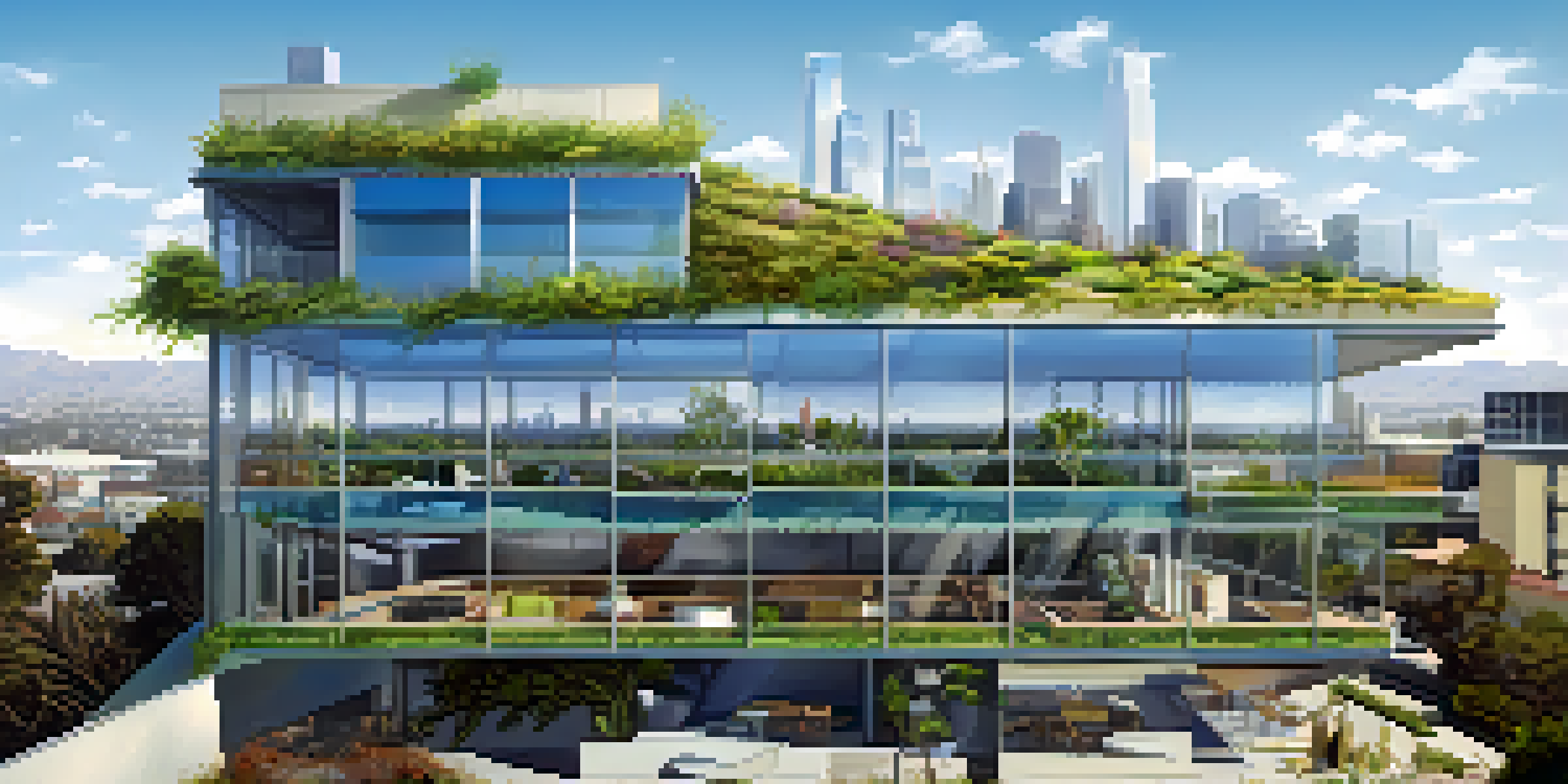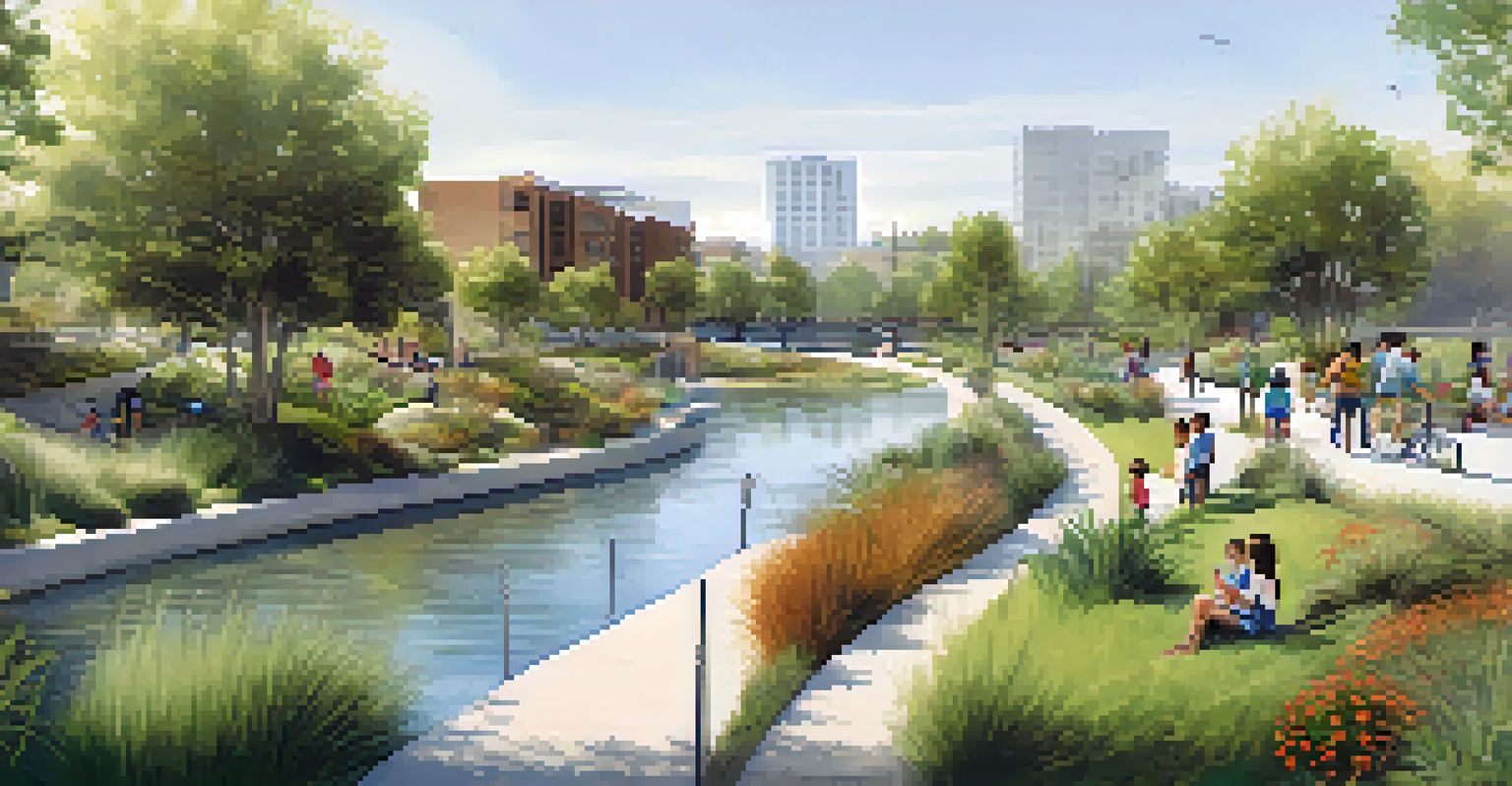The Rise of Sustainable Architecture in Los Angeles Designs

Understanding Sustainable Architecture in LA
Sustainable architecture focuses on minimizing environmental impact while maximizing energy efficiency. In Los Angeles, where urban sprawl meets a need for environmental responsibility, this approach is gaining traction. It’s about designing buildings that not only look good but also function harmoniously with their surroundings, creating a healthier environment.
Sustainability is no longer about doing less harm. It's about doing more good.
The essence of sustainable architecture is integrating eco-friendly materials, energy-efficient systems, and innovative design practices. For example, buildings that harness solar energy or use reclaimed water systems are becoming more commonplace. These strategies reflect a growing awareness among architects and homeowners about their ecological footprint.
This shift is not just a trend; it’s a necessity as cities face climate challenges. By embracing sustainable practices, architects in Los Angeles are leading the charge toward a greener future, creating spaces that support both residents and the planet.
Key Features of Sustainable Designs
Sustainable architecture is characterized by several key features that set it apart from traditional designs. One of the most prominent is the use of renewable materials, such as bamboo or recycled steel, which reduce reliance on virgin resources. This not only conserves energy but also promotes a circular economy.

Another significant aspect is energy efficiency, which can be achieved through smart design choices like passive solar heating and natural ventilation. For instance, many new buildings in LA incorporate large windows that allow natural light to flood in, reducing the need for artificial lighting during the day. Additionally, green roofs and walls help insulate buildings while providing urban greenery.
Sustainable Design Benefits Communities
Sustainable architecture enhances community well-being by promoting healthier lifestyles and inclusivity.
Finally, the integration of smart technologies plays a crucial role in sustainable architecture. From automated lighting systems to energy management software, these innovations help monitor and reduce energy consumption, making it easier for residents to adopt eco-friendly habits without sacrificing comfort.
The Role of Local Regulations and Incentives
In Los Angeles, local regulations and incentives have been pivotal in promoting sustainable architecture. The city has implemented various policies aimed at encouraging green building practices, such as the Green Building Ordinance. This legislation outlines specific requirements for energy efficiency, water conservation, and sustainable materials in construction projects.
Green architecture is a way of life that benefits both people and the planet.
Additionally, programs like the California Green Building Standards Code provide guidelines that help architects and builders create environmentally friendly designs. By establishing clear benchmarks, these regulations ensure that sustainability is not just an afterthought but a fundamental aspect of every project.
Moreover, financial incentives such as tax breaks and grants for green renovations can make sustainable building practices more accessible. These initiatives not only motivate developers to adopt eco-friendly designs but also make it easier for homeowners to retrofit their properties, leading to a broader impact on the community.
Community Impact of Sustainable Architecture
Sustainable architecture does more than just reduce environmental impact; it also fosters community well-being. Thoughtfully designed buildings can enhance quality of life by promoting healthier lifestyles. For example, projects that include green spaces or community gardens encourage outdoor activities and social interactions among residents.
Additionally, sustainable designs often prioritize accessibility and inclusivity. By integrating features like ramps, wide doorways, and family-friendly layouts, architects can create spaces that cater to diverse needs. This commitment to inclusivity strengthens community ties and ensures that everyone can benefit from these eco-friendly spaces.
Local Regulations Propel Green Building
Los Angeles’ policies and financial incentives encourage the adoption of sustainable architecture practices among developers and homeowners.
Furthermore, sustainable architecture can stimulate local economies by attracting businesses and residents who prioritize environmental responsibility. As more people seek out green living options, neighborhoods with sustainable designs become desirable places to live, work, and play.
Innovative Projects Leading the Way
Los Angeles is home to several innovative projects that exemplify the rise of sustainable architecture. One notable example is the Bullitt Center, often referred to as the greenest commercial building in the world. It features a living roof, rainwater harvesting, and a net-zero energy design, setting a high standard for future developments.
Another inspiring project is the LA River Revitalization, which aims to transform a concrete waterway into a vibrant green space. This initiative not only enhances biodiversity but also creates recreational opportunities for residents, demonstrating how sustainable design can benefit the community as a whole.
These projects serve as a blueprint for architects and builders across the city, showcasing that sustainable architecture is both feasible and beneficial. As more developers embrace these innovative strategies, we can expect to see an even greater impact on the landscape of Los Angeles.
Challenges Facing Sustainable Architecture
Despite its many benefits, sustainable architecture in Los Angeles faces several challenges. One of the most significant hurdles is the upfront cost associated with green building materials and technologies. While these investments often lead to long-term savings, they can deter developers from pursuing sustainable options initially.
Additionally, there can be a lack of awareness or understanding of sustainable practices among stakeholders, including homeowners and builders. Education is key to overcoming this barrier; when people realize the benefits of sustainable architecture, they are more likely to support and adopt these practices.
Innovative Projects Set New Standards
Cutting-edge projects like the Bullitt Center showcase that sustainable architecture is both feasible and beneficial for urban environments.
Finally, regulatory hurdles can slow down the adoption of eco-friendly designs. Navigating complex zoning laws and building codes can be daunting, and some developers may shy away from projects that require extensive modifications. Addressing these challenges is essential for the continued growth of sustainable architecture in Los Angeles.
The Future of Sustainable Architecture in LA
Looking ahead, the future of sustainable architecture in Los Angeles appears promising. As public awareness of environmental issues grows, there is an increasing demand for eco-friendly designs. Architects and builders are responding by innovating and pushing the boundaries of what sustainable architecture can achieve.
Technological advancements also play a crucial role in shaping the future of sustainable architecture. Innovations like 3D printing and modular construction can reduce waste and streamline the building process, making it easier to create sustainable structures. As these technologies become more mainstream, we can expect to see a rise in green building projects.

Ultimately, the commitment to sustainability in architecture reflects a broader societal shift toward environmental stewardship. As Los Angeles continues to embrace these practices, it sets an example for other cities to follow, proving that sustainable architecture is not just a trend, but a vital component of a livable, resilient future.